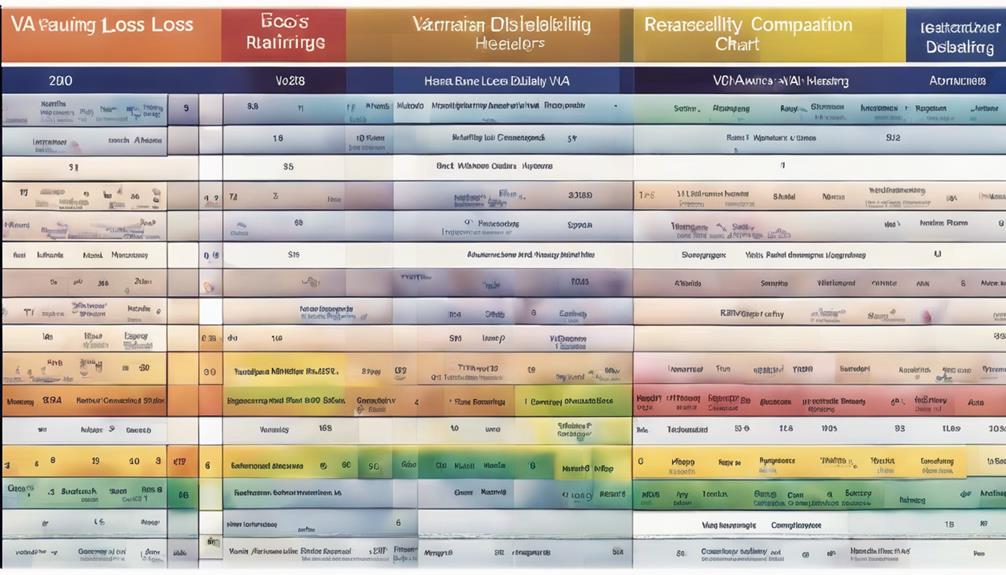When dealing with VA disability, understanding the evaluation process for hearing loss is a crucial step. Knowing the specific criteria for qualifying for VA benefits is essential for receiving the necessary support.
By unraveling the nuances of eligibility criteria, evaluation processes, and potential compensation, we shed light on a crucial aspect of veterans' well-being. Join us in uncovering the significance of this guide to empower and assist those who have served our nation.
Key Takeaways
- VA disability ratings for hearing loss range from 0% to 100% based on severity and impact.
- Recognition of sensorineural, conductive, or mixed hearing loss types is crucial for VA evaluation.
- Filing accurately with supporting evidence and detailing the impact enhances approval chances.
- Consistent use of treatment, like hearing aids, and establishing service connection are vital for maximizing benefits.
VA Disability Criteria for Hearing Loss
When evaluating VA Disability for Hearing Loss, the criteria used includes a rating scale from 0% to 100% based on factors such as puretone thresholds, speech discrimination, diagnosis, and the cause of the hearing impairment. This comprehensive approach allows for a thorough assessment of veterans' hearing abilities and the impact of any loss on their daily lives. The VA recognizes that hearing loss can significantly affect communication, relationships, and overall quality of life for veterans.
The VA's disability ratings for hearing loss are crucial in determining the level of compensation veterans may receive. These ratings take into account the severity of hearing loss, its impact on speech discrimination, and whether the impairment is service-connected. By considering both ears together, the VA aims to provide fair and accurate ratings that reflect the overall impact of hearing loss on an individual. Understanding the VA's criteria for rating hearing loss is essential for veterans seeking medical and financial support for their service-related disabilities.
Types of Recognized Hearing Loss

Recognizing various types of hearing loss is essential for determining eligibility for VA disability benefits, with the VA acknowledging sensorineural, conductive, and mixed forms of hearing impairment.
Sensorineural hearing loss, the most common type recognized by the VA, affects the inner ear or auditory nerve pathways, often caused by aging or exposure to loud noises.
Conductive hearing loss, stemming from blockages in the outer or middle ear, is also considered for VA disability benefits. This type may result from issues like earwax buildup, infections, or abnormalities in the ear structure.
Mixed hearing loss, which combines sensorineural and conductive elements, is evaluated by the VA when determining disability compensation. Furthermore, blast injuries or trauma can lead to any of these recognized types of hearing loss, underlining the importance of thorough assessment for veterans seeking VA support.
Understanding these distinctions is crucial for accurately assessing and addressing veterans' hearing-related disabilities.
VA Evaluation Process for Hearing Loss
In evaluating hearing loss for VA disability benefits, the process includes conducting speech discrimination and puretone audiometry tests. These tests help assess the severity of the hearing impairment and determine the appropriate disability ratings for hearing loss. The VA considers various factors such as puretone thresholds, speech discrimination ability, diagnosis, and the cause of the hearing loss when evaluating a veteran's condition.
It's important to note that hearing loss and tinnitus are evaluated separately during this process. The evaluation takes into account both ears together to determine the overall impact on hearing. Understanding the VA evaluation process for hearing loss is crucial for veterans seeking service-connected disability benefits.
This evaluation is typically conducted as part of a Compensation and Pension (C&P) exam to assess the extent of hearing loss and its impact on daily life, ensuring veterans receive the VA benefits they deserve.
Filing for VA Hearing Loss Benefits

To apply for VA hearing loss benefits, veterans can submit a claim online, in person, or by mail along with the necessary military service information. When filing a VA hearing loss claim, it's essential to include supporting evidence such as statements from family or coworkers to strengthen the application.
VA representatives carefully review these applications, schedule Compensation and Pension (C&P) exams as needed, and assess eligibility for disability benefits based on the information provided. Accuracy in detailing the impact of hearing loss, adherence to recommended medical care, and the submission of additional supporting evidence are crucial for a successful claim.
For veterans with hearing loss, obtaining compensation for hearing loss benefits can significantly improve their quality of life. Seeking assistance from a qualified VA representative or attorney can further enhance the chances of maximizing VA hearing loss benefits and navigating the claims process efficiently.
Maximizing VA Hearing Loss Benefits
Maximizing VA hearing loss benefits requires meticulous documentation of the impact of the condition and adherence to prescribed treatment plans.
For age-related hearing loss, providing comprehensive medical evidence detailing the functional impact on daily activities is crucial.
The VA Rating for Hearing is determined based on the severity of the hearing loss, with benefits varying across different hearing loss ranges.
Demonstrating the consistent use of hearing aids can support your VA disability claim, showcasing the efforts made to mitigate the impairment.
Additionally, establishing a clear service connection between your hearing loss and military service through relevant records enhances your case for benefits.
Including detailed information on how the hearing loss affects communication, work, and quality of life can further strengthen your application.
Working closely with a qualified VA representative or attorney can offer valuable guidance in maximizing your VA disability benefits for hearing loss.
If needed, appealing for a higher disability rating can also be pursued to ensure you receive the appropriate level of support.
Frequently Asked Questions
What Is the Average VA Rating for Hearing Loss?
We can confirm that the average VA rating for hearing loss is 10%.
This rating signifies mild to moderate impairment, reflecting the common experience among veterans and its impact on daily life.
Those with this rating may face challenges in specific listening environments and could benefit from interventions such as hearing aids.
The 10% rating indicates the level of functional limitation due to hearing loss as determined by the VA.
Is 30% Hearing Loss a Disability?
We believe that a 30% hearing loss is considered a disability by the VA.
This level of impairment can significantly impact daily life and communication abilities.
Veterans with a 30% hearing loss rating may struggle to hear conversations in noisy settings or understand speech without help.
Accommodations and support are often necessary for individuals with this level of hearing loss to manage their condition effectively.
What Is the C&P Exam for Hearing Loss?
The C&P exam for hearing loss is a comprehensive evaluation by the VA. It involves tests like speech discrimination and puretone audiometry to determine the severity of one's hearing impairment.
This exam is crucial in deciding disability ratings and eligibility for VA benefits related to hearing loss. Results from the C&P exam provide insights into how hearing loss impacts daily life and functioning.
It's a standard part of the process for veterans seeking compensation for service-connected hearing issues.
How Do You Calculate Hearing Loss Disability?
When calculating hearing loss disability, we rely on puretone audiometry tests to determine the severity. These tests establish thresholds that guide the VA in assigning disability ratings.
Additionally, speech discrimination testing is crucial in evaluating communication impairment. Our process considers the degree of hearing loss and speech understanding to accurately assess disability.
Conclusion
As we unravel the complexities of VA disability for hearing loss, we uncover a world of possibilities for veterans seeking support. Understanding the criteria, types, evaluation process, and filing procedures is just the beginning.
By maximizing VA benefits, veterans can unlock a realm of opportunities for financial assistance and medical care. Stay tuned as we continue to explore the intricate web of VA disability ratings and the journey towards reclaiming the quality of life for those who've served.











